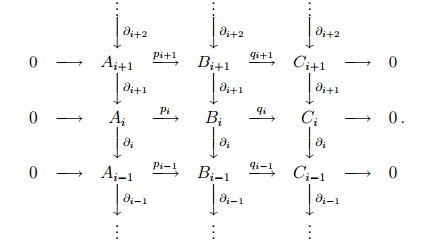

تاريخ الرياضيات

الاعداد و نظريتها

تاريخ التحليل

تار يخ الجبر

الهندسة و التبلوجي


الرياضيات في الحضارات المختلفة

العربية

اليونانية

البابلية

الصينية

المايا

المصرية

الهندية


الرياضيات المتقطعة

المنطق

اسس الرياضيات

فلسفة الرياضيات

مواضيع عامة في المنطق


الجبر

الجبر الخطي

الجبر المجرد

الجبر البولياني

مواضيع عامة في الجبر

الضبابية

نظرية المجموعات

نظرية الزمر

نظرية الحلقات والحقول

نظرية الاعداد

نظرية الفئات

حساب المتجهات

المتتاليات-المتسلسلات

المصفوفات و نظريتها

المثلثات


الهندسة

الهندسة المستوية

الهندسة غير المستوية

مواضيع عامة في الهندسة

التفاضل و التكامل


المعادلات التفاضلية و التكاملية

معادلات تفاضلية

معادلات تكاملية

مواضيع عامة في المعادلات


التحليل

التحليل العددي

التحليل العقدي

التحليل الدالي

مواضيع عامة في التحليل

التحليل الحقيقي

التبلوجيا

نظرية الالعاب

الاحتمالات و الاحصاء

نظرية التحكم

بحوث العمليات

نظرية الكم

الشفرات

الرياضيات التطبيقية

نظريات ومبرهنات


علماء الرياضيات

500AD

500-1499

1000to1499

1500to1599

1600to1649

1650to1699

1700to1749

1750to1779

1780to1799

1800to1819

1820to1829

1830to1839

1840to1849

1850to1859

1860to1864

1865to1869

1870to1874

1875to1879

1880to1884

1885to1889

1890to1894

1895to1899

1900to1904

1905to1909

1910to1914

1915to1919

1920to1924

1925to1929

1930to1939

1940to the present

علماء الرياضيات

الرياضيات في العلوم الاخرى

بحوث و اطاريح جامعية

هل تعلم

طرائق التدريس

الرياضيات العامة

نظرية البيان
Introduction to Homological-Chain Complexes
المؤلف:
David R. Wilkins
المصدر:
Algebraic Topology
الجزء والصفحة:
...
6-7-2017
2888
Definition A chain complex C∗ is a (doubly infinite) sequence (Ci: i ∈ Z) of modules over some unital ring, together with homomorphisms ∂I : Ci → Ci−1 for each i ∈ Z, such that ∂i ◦ ∂i+1 = 0 for all integers i.
The ith homology group Hi(C∗) of the complex C∗ is defined to be the quotient group Zi(C∗)/Bi(C∗), where Zi(C∗) is the kernel of ∂i: Ci → Ci−1 and Bi(C∗) is the image of ∂i+1: Ci+1 → Ci .
Note that if the modules C∗ occuring in a chain complex C∗ are modules over some unital ring R then the homology groups of the complex are also modules over this ring R.
Definition Let C∗ and D∗ be chain complexes. A chain map f: C∗ → D∗ isa sequence fi: Ci → Di of homomorphisms which satisfy the commutativity condition ∂i ◦ fi = fi−1 ◦ ∂ifor all i ∈ Z.
Note that a collection of homomorphisms fi : Ci → Di defines a chain map f∗: C∗ → D∗ if and only if the diagram

is commutative.
Let C∗ and D∗ be chain complexes, and let f∗: C∗ → D∗ be a chain map.
Then fi(Zi(C∗)) ⊂ Zi(D∗) and fi(Bi(C∗)) ⊂ Bi(D∗) for all i. It follows from this that fi : Ci → Di induces a homomorphism f∗: Hi(C∗) → Hi(D∗) of homology groups sending [z] to [fi(z)] for all z ∈ Zi(C∗), where [z] = z + Bi(C∗), and [fi(z)] = fi(z) + Bi(D∗).
Definition A short exact sequence 0−→A∗ p∗→B∗ q∗→C∗→0 of chain complexes consists of chain complexes A∗, B∗ and C∗ and chain maps p∗: A∗ → B∗ and q∗: B∗ → C∗ such that the sequence
0→Ai pi →Bi qi→Ci→0
is exact for each integer i.
We see that 0→A∗p∗ −→B∗q∗→C∗→0 is a short exact sequence of chain complexes if and only if the diagram

Lemma 1.1 Given any short exact sequence 0→A∗p∗→B∗q∗→C∗→0 of chain complexes, there is a well-defined homomorphism
αi: Hi(C∗) → Hi−1(A∗)
which sends the homology class [z] of z ∈ Zi(C∗) to the homology class [w] of any element w of Zi−1(A∗) with the property that pi−1(w) = ∂i(b) for some b ∈ Bi satisfying qi(b) = z.
Proof Let z ∈ Zi(C∗). Then there exists b ∈ Bi satisfying qi(b) = z, since
qi: Bi → Ci is surjective. Moreover
qi−1(∂i(b)) = ∂i(qi(b)) = ∂i(z) = 0.
But pi−1: Ai−1 → Bi−1 is injective and pi−1(Ai−1) = ker qi−1, since the sequence
0−→Ai−1 pi−1−→Bi−1 qi−1→Ci−1
is exact. Therefore there exists a unique element w of Ai−1 such that ∂i(b) =pi−1(w). Moreover
pi−2(∂i−1(w)) = ∂i−1(pi−1(w)) = ∂i−1(∂i(b)) = 0
(since ∂i−1 ◦ ∂i = 0), and therefore ∂i−1(w) = 0 (since pi−2: Ai−2 → Bi−2 is injective). Thus w ∈ Zi−1(A∗).
 الاكثر قراءة في التبلوجيا
الاكثر قراءة في التبلوجيا
 اخر الاخبار
اخر الاخبار
اخبار العتبة العباسية المقدسة

الآخبار الصحية















 قسم الشؤون الفكرية يصدر كتاباً يوثق تاريخ السدانة في العتبة العباسية المقدسة
قسم الشؤون الفكرية يصدر كتاباً يوثق تاريخ السدانة في العتبة العباسية المقدسة "المهمة".. إصدار قصصي يوثّق القصص الفائزة في مسابقة فتوى الدفاع المقدسة للقصة القصيرة
"المهمة".. إصدار قصصي يوثّق القصص الفائزة في مسابقة فتوى الدفاع المقدسة للقصة القصيرة (نوافذ).. إصدار أدبي يوثق القصص الفائزة في مسابقة الإمام العسكري (عليه السلام)
(نوافذ).. إصدار أدبي يوثق القصص الفائزة في مسابقة الإمام العسكري (عليه السلام)


















